1989 Australian Grand Prix race report
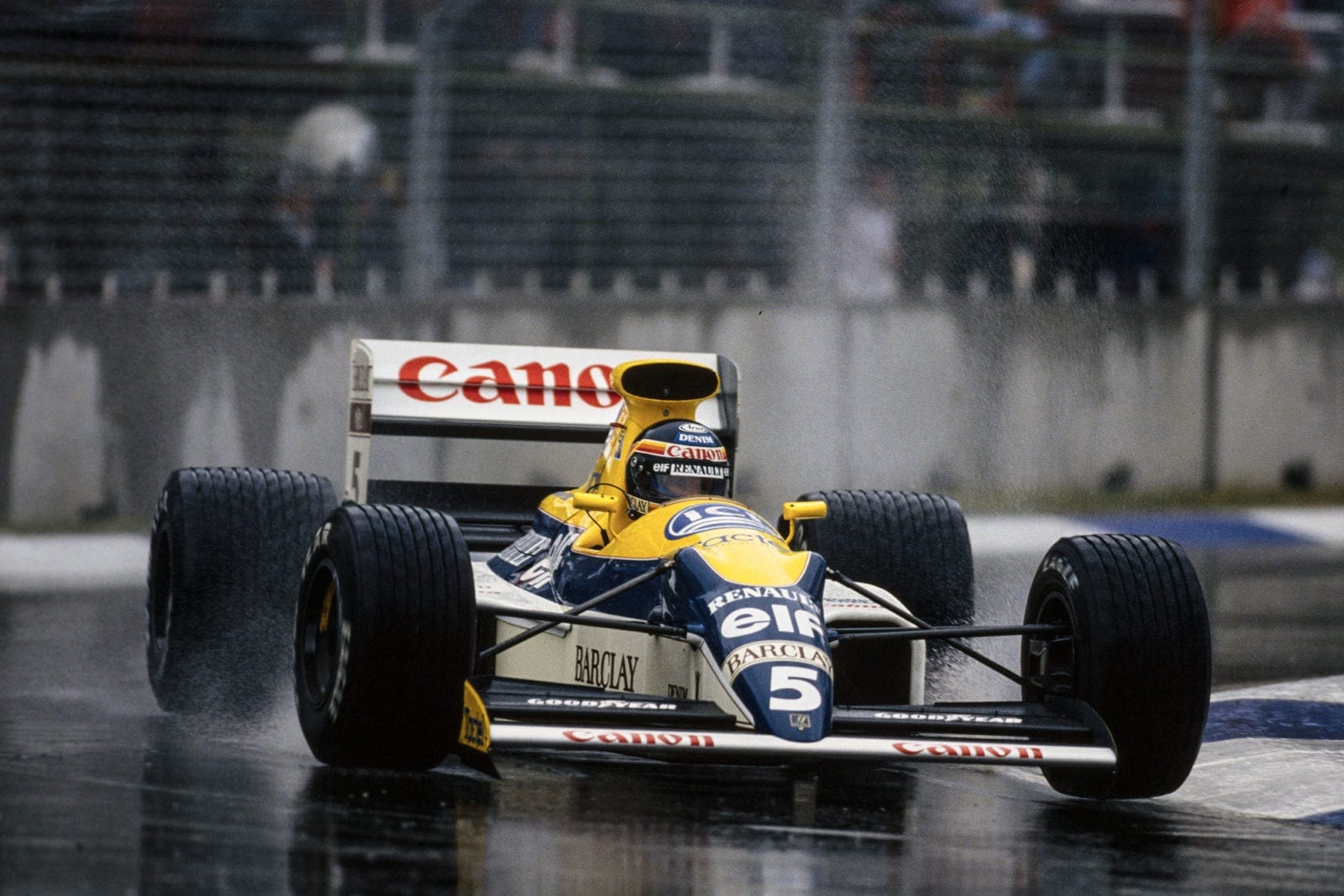
Williams' Thierry Boutsen won a wet race of attrition
Motorsport Images
Insanity rules
“When I retired, they should have stopped it. Nothing more could have happened that could have affected the championship, so there was no further point in risking people’s lives.”
If Ayrton Senna sounded a little arrogant after his spectacular exit from Adelaide’s rain-soaked streets, his suggestion had the thread of logic that was missing from the officials’ viewpoint of the race.
After he’d three-wheeled his way back to the sanctuary of the pits, Senna had called Ron Dennis and his waterlogged men together to discuss his future. The championship lost, he even hinted at possible retirement.
“I will go back to Brazil now,” he told the media, “to think over everything that has happened. One option is that I may not come back.”
What was this? Hadn’t he been outlining his steely resolve to pursue to the bitter end his battle with FISA, not three days earlier? The emotional Brazilian had been under massive pressure from the moment the Japanese GP had begun. It had got worse when Prost had beaten him off the line, and gone into overdrive the instant he and his team-mate. tangled on lap 47. With FISA’s outburst the week prior the Australian GP was anything but restful for him. FISA might have declared the Frenchman World Champion, but Senna believed implicitly that he would win the Suzuka appeal, and tried to prepare for his final shot in Adelaide against that background of acrimony. The Thursday before the race his feelings were laid bare as he addressed the world’s motorsport media, and the intensity of his impassioned appeal for help in his fight provided a highly illuminating insight into F1’s most complex character.
It would have taken a cynical man indeed to reject his sincerity, and he made a very strong impression that went a long way towards softening his image as an Iceman. The pressure, it seemed, was lifted temporarily, until a nasty little incident on Friday afternoon when his ego was threatened by Prost pipping him for the overnight pole.
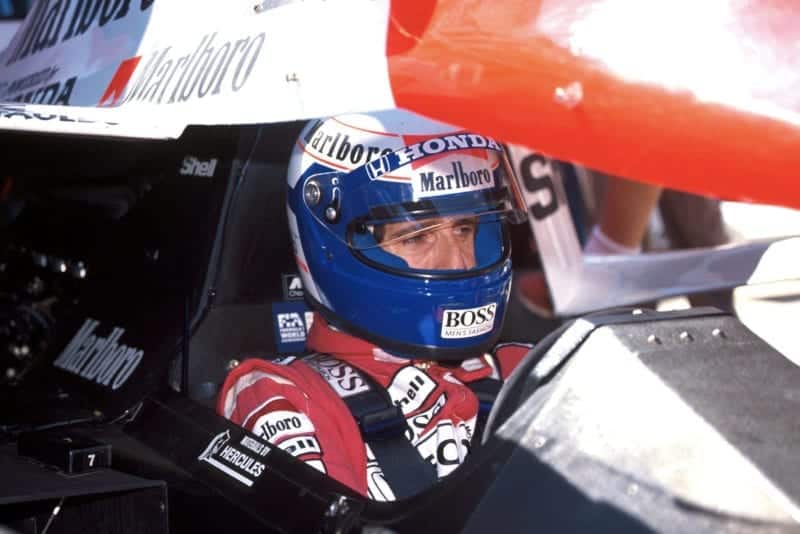
Alain Prost put his McLaren on pole
Motorsport Images
To those who saw the moment between them, it was apparent that Prost had overtaken a slow-moving Berger at the end of his quick lap, as Senna came storming up behind both. Prost then braked hard and moved as far off line as possible to give Senna uninterrupted passage, but Ayrton saw it differently. He saw it as something that made him lift for a split second, and a likely 1m 16.9s lap became lm 17.712s, slower than Prost’s 1 m 17.403s. It took a long time for Ron Dennis to unruffle his feathers as Ayrton threatened to report Prost to the stewards for allegedly passing Berger under a yellow flag. “He’s mad,” said Prost curtly, which comment simply added fuel to the fire of his remark the previous day: “Ayrton’s trouble is that because he believes in God he doesn’t think he can be killed.”
But despite all that, Senna was yet again in scintillating form to take the pole — his 42nd — on Saturday, and when the rains came on Sunday he was one of very few drivers determined to start. The organisers laid on an acclimatisation session for the F1 pilots, and when Mansell and Nannini had big accidents, the mood darkened. Boutsen, Patrese, Piquet, Berger and Prost led a faction seeking to have the race delayed, in the hope of giving the conditions time to improve. Prost, predictably, took the brunt of any criticism that was going, but was in fact one of several drivers involved.
“I don’t care what people think of what I’m doing,” said Piquet. “Look, my car is brilliant in the wet, but I’m so far back on the grid I just know I’m going to become involved in a shunt. Mine, or someone else’s. I’m telling you, the conditions out there are the worst I’ve ever encountered.” What made them so bad was that the streets of Adelaide don’t drain well, while the concrete walls that line them simply trap the spray thrown up by each car. Aquaplaning was rife, visibility nil. “I was just a passenger when I hit that puddle this morning,” said Mansell, who was equally adamant that the race should, at the least, be delayed. Patrese and Piquet toured the circuit in a road car with former F1 racer Tim Schenken, who was Clerk of the Course, and official starter Roland Bruynseraede, but after a small delay everyone was duly strapped in. Resistance, it seemed, had crumbled. Senna was already in his McLaren, outwardly calm, ready to race. Ken Tyrrell had obliged Jean Alesi to get into the Tyrrell. The Australian GP was going to happen, come what may.
And yet … “Even if I was fighting for the championship I would take this decision,” said Prost, after he had, as planned, pulled into the pits in protest after one lap. The Frenchman had led Senna off the line before the Brazilian elbowed by — “the usual manoeuvre” — but had expected company in the pits. Berger had also intended to stop, but carried on after all. Clearly ashamed of himself afterwards, he said: “I don’t know what’s wrong with us. We’re hopeless. Me, Riccardo, Thierry. One minute we’re in the car, then we’re out. Then in again. Alain was in and out. Why did he get out? Why did I get in?”
The Austrian was also scathing about that first start, the worst in recent F1 history. Why it went ahead is anybody’s guess, but half the field were out of position, Mansell, Piquet and Berger weren’t even in their cars at the 30s signal, and Cheever was still coming round to his grid position when the lights went green. Both he and Mansell had to pass the chase car containing Prof Sid Watkins and driver Frank Gardner.
“Bloody ridiculous,” growled the Prof. “We couldn’t see a damned thing.” When JJ Lehto dumped his Onyx on that lap and blocked the track, the race was red flagged. Prost and Piquet did another lap with Schenken and Bruynseraede, but this time Tim wasn’t shifting. There would be no delay. That was it for Prost, even though McLaren had hopefully pushed his MP4/5 to the end of the pit road ready for him. Thus ended his final race with McLaren, and his last event of the decade.
That left Senna alone on the front row, but even the Brazilian had a negative view of the conditions. “If I hadn’t had a chance of the championship, I too would not have raced,” he disclosed. For once he and Prost were united in respect for the other’s decision. Each, in his own way, was being brave.
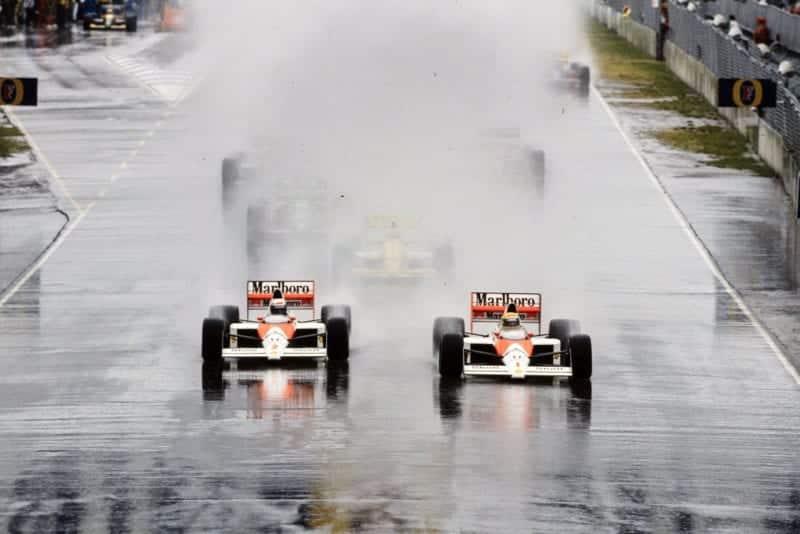
Prost and Ayrton Senna vie for the lead at the race start
Motorsport Images
And so the race went ahead. Senna, predictably, blasted into the distance, after a few anxious moments in which Pierluigi Martini ran side by side with him. The little Italian was in sparkling qualifying form to place his Minardi third on the grid, beaten only by the McLarens, but as Senna stretched the legs of his Honda horses, Piero slipped back to hold up the duelling Williams of Boutsen and Patrese, and Nannini’s Benetton.
The wet was made for Senna. By the end of that first lap his uncanny car control had already taken him eight seconds clear of Martini and his pursuers, and by the time the Williams drivers had slithered past the Pirelli-shod M189, on lap three the deficit was 23 seconds. As far as FISA was concerned, the championship was already Prost’s, but if by a miracle Senna’s Suzuka appeal was upheld and he won Adelaide, there might be an even greater controversy on the horizon. Unless the race failed to go beyond half distance, in which case Senna would only get half points …
That the track was almost undriveable became apparent very early. Rene Arnoux spun out of his last GP after a light tap from Cheever (and later presented his driving colleagues with leather-bound, personally signed books as he bade adieu). Alesi, who started from the pit lane after his engine refused to fire, was another spinner. Larini’s engine had refused to start on the grid too, but perhaps luckily for him he never did get going.
On lap seven Alliot nipped Berger in the hairpin at the end of Dequetteville Terrace, and as the Ferrari lost its nosewings the Lola spun and Gerhard rode over its right front wheel. It was the some spot in which he’d tangled with Arnoux in 1988. For Alliot it was the end of his Larrousse career, for Berger the end of his days with the Prancing Horse. In qualifying he had been upset to suffer gearbox failure in his race car and find he wasn’t allowed use of the spare, “because it has a development engine, which I’m not supposed to know about. Some way to find out about it, eh?” Worse, he was sorry he hadn’t backed Prost more.
As he did in Canada, Derek Warwick was charging in his last race for Arrows. Though he’d only qualified 20th he was up to a stunning seventh on lap eight when his engine cut momentarily before chiming in again and powering him into the same wall he’d struck on the first day of qualifying.
De Cesaris had done well to qualify ninth ahead of team-mate Caffi, but though both ran well initially their Dallaras were a handful on their Pirellis, just as they had been in qualifying when both were mystified by Martini’s performance. Andrea had three big spins before he was finally unable to restart, while Alex backed his BMS189 into a wall and limped painfully away on lap 14.
That lap saw Ivan Capelli’s hopes die with a punctured radiator, and the March driver would be one of the very few who quit because of a mechanical cause, rather than through accident.
Lap 14, too, was the one on which Ayrton Senna came to grief. The Brazilian had continued to extend his lead over Boutsen, and by lap 10 he was more than a minute ahead. Then came a massive spin on lap 11, in which the McLaren revolved two and a half times before coming to rest half off the track but virtually facing the right way. Senna kept the Honda V10 running, kept everything off the wall, and calmly rejoined without losing any more than seven seconds of his lead. Like the spin he’d had in the acclimatisation session, recovery from it was a masterly piece of driving. But then, as he came to lap Piquet on lap 14, he simply drove straight into the back of Brundle’s Brabham, with which his fellow countryman was dicing.
“The first I saw of Martin was when my left front wheel came off and I realised I’d hit him,” said Ayrton. It was one of racing’s luckiest escapes. Had he hit Brundle’s right rear wheel and gone over the back of the Brabham, Piquet would almost certainly have ploughed into the wreckage.
It was exactly the sort of accident Prost had predicted, exactly why he had been so angry that the organisers let the race start. The Frenchman was roundly criticised by many at Silverstone last year, and again in Adelaide, but he, remember, was the one over whose rear wheel Didier Pironi rode at Hockenheim in 1982 …
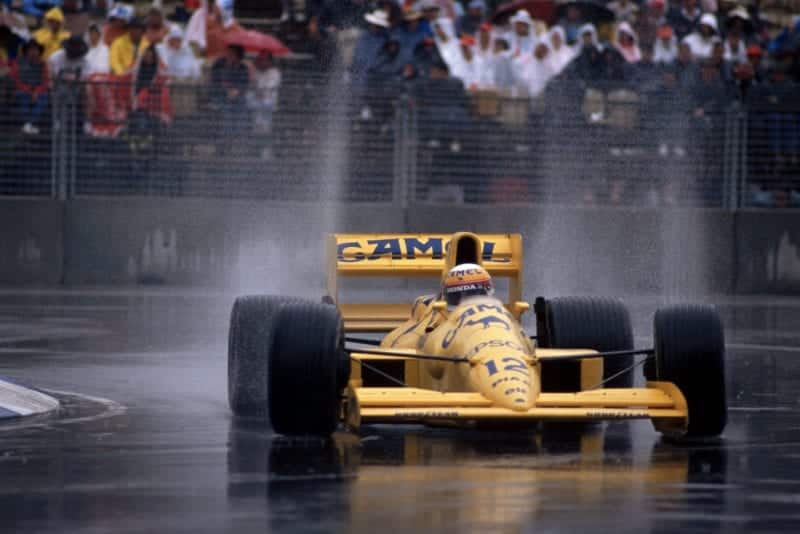
Satoru Nakajima secured 5th place for Lotus
Motorsport Images
As Ayrton suggested, that would have been an apposite point at which to end the farce, but greater forces were at work behind the scenes, and on it went.
On lap 10 it was Mansell’s turn for a big 360, but amazingly he gathered it all together. His demise wasn’t far off, however. Going into the same corner on lap 18 he missed his turn-in point in the ball of spray and had to spin the F1/89 to make the corner. It went backwards into the tyre wall, and the Briton was out yet again Down Under.
If drivers of the calibre of Senna and Mansell could make mistakes, it was a graphic indication of how bad things were, but that didn’t budge the organisers. The game of Russian Roulette went on, and the trigger’s hammer nearly struck a live bullet two laps later.
This time the gun was aimed at Piquet’s head, proving both his own and Prost’s pre-event warnings chillingly accurate.
As he sped down to the braking area at the end of Dequetteville, Nelson had Martini on his left and was aiming to outbrake the Minardi. While concentrating on that move he just didn’t see Ghinzani’s Osella, which the Italian was dutifully keeping well to the right, in the ball of spray ahead. The Lotus ran right into it, scooping it up so that its rear wheels slithered right up the 101’s cockpit. One even struck Nelson’s head, leaving a rubber scorchmark on his helmet.
The Osella was thrown left across the track, and the Lotus spun backwards down the escape road, minus its left front wheel. As it did so, it just missed involving he Minardi.
By nothing short of a miracle, neither Piquet our a bruised Ghinzani was hurt, but if the Lotus hadn’t been braking it could have been a very different story.
And still the race went on. Just how bad was it out there? Brundle’s comments indicated just how frightening it was. “Just before Ayrton hit me I’d had a bloody great spin flat in sixth on the straight. The thing just got up on a puddle and round it went, twice. A complete double 360. Luckily I came out facing the right way and didn’t hit anything. After that I was taking the straight in fifth, because our biggest fear in the wet is spinning and ending up broadside to oncoming cars”.
The evidence from his rearward facing TV camera showed just how little visibility there was. One moment the Brabham was chased only by its own roostertail; the next a shark-like McLaren loomed out of the mist and took a bite out of its gearbox.
When Oliver Grouillard’s enthusiastic chase of Emanuele Pirro got the better of the Frenchman on lap 23, and he dumped his Ligier hard into the wall and came to rest patially blocking the track, it seemed at that the farce must be ended, but amazingly enough it continued. Cheever picked up debris from the JS33 under his left-hand sidepod, and though the American was driving smoothly in his last GP in the immediate future, he later lost it on lap 43 and was unable to restart. Yet another victim had fallen.
Eddie in fact was the race’s final retirement, but one of its most exciting contenders had been Lehto, who fell foul of a similar problem to Warwick’s on lap 28. The Finn had made it through prequalifying at the expense of Onyx team-mate Stefan Johansson, had qualified well on his first visit to Adelaide, and was driving beautifully on his first wet outing in an F1 car. He and Nakajima kept one another company, swapping places as they carved through the field. JJ was an excellant fifth, still in sight of the Lotus, when his engine fluffed. Make no mistake this is one of tomorrow’s stars.
If interest in Adelaide centred minly on the incredible number of incidents, Nakajima was a major talking point. What got into him in Australia ? Only 23rd on the grid after a lacklustre qualifying in the dry, he was simply magic in the wet. Okay, back home in Suzuka and Fuji, during the formative part of his career, rain was a common condition, but in Adelaide he was a absolute ace. If he never betters his performance there, he will still have something to be thoroughly proud of.
By lap 4 he’d moved up to 16th. Pirro then lost out to the Japanese as he chased Lehto, spinning briefly on lap 9, and by lap 11 Satoru was 10th. Thereafter he continued to move steadily up, lapping smoothly. His only error came with a first-lap spin, and by lap 24 he had displaced Cheever for 4th, but the deficit to Patrese looked insurmountable at 35 secs.
The Italian had an adventurous race. On lap 10 he squeezed past Boutsen, only to drop back two corners later when he speared off into he mud. He survived another spin which dropped him behind Nannini and Mansell, and thereafter concentrated on finishing third, since that would bring him the points he was so desperate to score to move ahead of Mansell for third in the championship. By lap 41 Nakajima was only 23s adrift, and as he set several fastest laps the Camel yellow Lotus began to creep up on the Canon Williams. By lap 50, by which time it was crystal clear the organisers were going to let the race run to the two hour mark, the gap was only 15s and closing all the time. Mesmerised, observers watched Nakajima drive his heart out, and by lap 67 the gap was down to a tantalising 1.707s. Patrese, however, had been lucky passing Stefano Modena, who was soldiering on with appalling lack of grip in his Pirelli-shod Brabham. Satoru was not so fortunate, and next time round the advantage had grown to 4.672s. That was pretty much where it stayed until the end, as Riccardo dipped below the 1m 40s mark just to make sure, but Nakajima’s drive was the most revealing of the race.
Boutsen, however, was a real star. Having disposed of Patrese’s challenge he assumed the lead from the tricycling Senna on lap 14 and thereafter controlled the event. Less of a fighter than the other topliners, perhaps, he was in his element as he was able to concentrate on maintaining his rhythm and honing his style, and the sheer consistency of his drive was astonishing. For lap after lap he reeled off laps in the lm 40s, the time usually varying only by tenths, and he never looked like making a mistake all afternoon. He had a minor drama when trying to lap Piero early on, as the Benetton driver inadvertently baulked him to the point where team-mate Nannini reduced a 9.4s deficit to 1.4, but once past and having indulged in a little tension-relieving arm waving, Thierry picked up his pace again and Nannini began to fall back. The Benetton had again qualified well with Ford’s development V8, but its standard race unit was the package wasn’t a match for the Williams-Renault’s torquey flexibility.
Boutsen thus raced home to the second win of his career, and one that was thoroughly deserved, while Pirro survived for fifth from the gripless Martini, the struggling Gugelmin and Modena. But the fifth Australian GP raised many more questions than it answered. And very soon now F1 is going to have to address the entire question of racing in the rain.
It must also address commercial interests. Berger, still blazing, was trenchant. “FISA should stop speaking about safety and start talking about business. It can only be interested in money if it sanctioned an event in these conditions. It proves that disqualifying Senna from Suzuka was a political decision.
“It was 100 times more dangerous what we did here than what he did in Japan, and there was no comparison with Spa. It was unbelievably bad.” Not finished, he added: “And whoever was responsible for that first start should get the electric chair.”
“There is a difference between being brave and being stupid,” said Piquet. “This is a dangerous sport and it doesn’t need to be made any more dangerous.”
“I cannot understand the sense of these people going out in these conditions,” said Prost.
Organiser Mel Hemmerling took a more pragmatic view when questioned about the commercial interests. “The drivers don’t know what the commercial considerations are, so why should they worry them?” he enquired ingenuously. It was the sort of remark that typified the thinking behind the Australian GP going ahead.
In this instance, there were not only commercial but political pressures, however, for South Australian premier John Bannen has used the GP as a vote-catching and industrial development selling tool and was due to face elections shortly afterwards. For the event to have been cancelled would have been a major black eye. As it was, it was a wash-out that might just have served him little benefit.
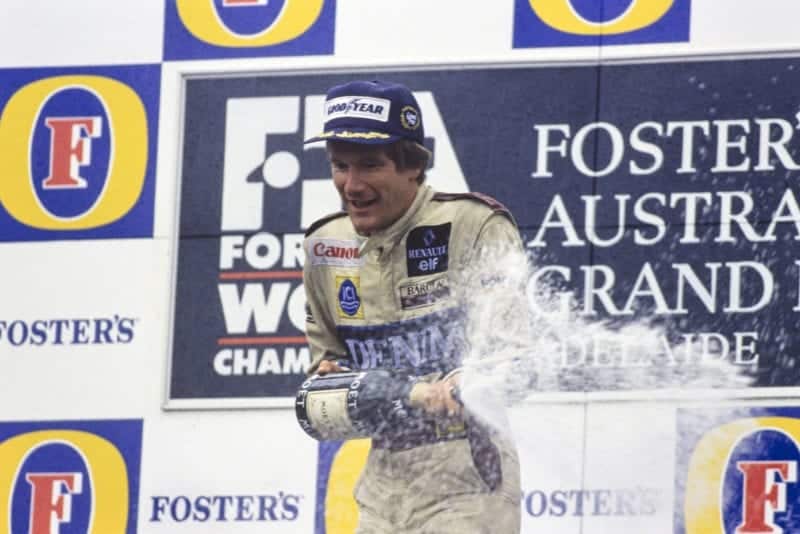
Boutsen celebrates his second career win
Motorsport Images
It’s easy to stand by in such situations and say ‘the drivers can always drive slowly’. I did so myself at one stage. Yet the major accidents proved the wisdom of cancellation. If you disagree, how would you feel if, in its immediate aftermath, you were reading with frustration the obituaries of Ayrton Senna and Nelson Piquet? No driver willingly wants to give up the chance to race, but they must be seen as the best judges of such situations. It is not dramatising the situation to say both Brazilians were very, very lucky. So, come to think of it, was F1. DJT
